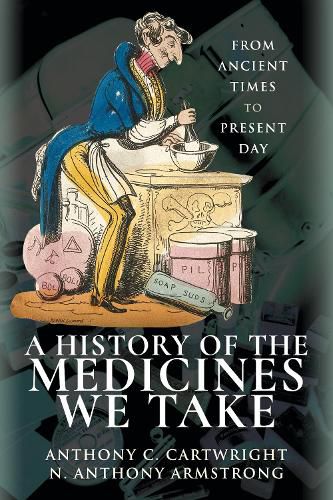Readings Newsletter
Become a Readings Member to make your shopping experience even easier.
Sign in or sign up for free!
You’re not far away from qualifying for FREE standard shipping within Australia
You’ve qualified for FREE standard shipping within Australia
The cart is loading…






A History of the Medicines We Take gives a lively account of the development of medicines from traces of herbs found with the remains of Neanderthal man, to prescriptions written on clay tablets from Mesopotamia in the third millennium BC, to pure drugs extracted from plants in the nineteenth century to the latest biotechnology antibody products. The first ten chapters of the book in PART ONE give an account of the development of the active drugs from herbs used in early medicine, many of which are still in use, to the synthetic chemical drugs and modern biotechnology products. The remaining eight chapters in PART TWO tell the story of the developments in the preparations that patients take and their inventors, such as Christopher Wren, who gave the first intravenous injection in 1656, and William Brockedon who invented the tablet in 1843. The book traces the changes in patterns of prescribing from simple dosage forms, such as liquid mixtures, pills, ointments, lotions, poultices, powders for treating wounds, inhalations, eye drops, enemas, pessaries and suppositories mentioned in the Egyptian Ebers papyrus of 1550 BCE to the complex tablets, injections and inhalers in current use. Today nearly three-quarters of medicines dispensed to patients are tablets and capsules. A typical pharmacy now dispenses about as many prescriptions in a working day as a mid-nineteenth- century chemist did in a whole year. AUTHOR: Anthony C. Cartwright is a retired pharmacist, who worked in the pharmaceutical industry, for the UK Medicines Agency, for a contract research company and in his own consultancy. He has written many reviews and research articles, written and co-edited three books on medicines regulation and contributed to four others. He is a Fellow of the Royal Pharmaceutical Society. He now writes on the history of medicine and pharmacy. He lives in Surrey with his wife. Norman Anthony Armstrong is a retired pharmacist who obtained his PhD at London University. After working in the pharmaceutical industry, he joined the Welsh School of Pharmacy, Cardiff University. He retired from there as senior lecturer in pharmaceutical technology. He is a Fellow of the Royal Pharmaceutical Society, and the author of over 170 scientific papers, reviews and books. He lives in Hertfordshire with his wife.
32 b/w illustrations
$9.00 standard shipping within Australia
FREE standard shipping within Australia for orders over $100.00
Express & International shipping calculated at checkout
A History of the Medicines We Take gives a lively account of the development of medicines from traces of herbs found with the remains of Neanderthal man, to prescriptions written on clay tablets from Mesopotamia in the third millennium BC, to pure drugs extracted from plants in the nineteenth century to the latest biotechnology antibody products. The first ten chapters of the book in PART ONE give an account of the development of the active drugs from herbs used in early medicine, many of which are still in use, to the synthetic chemical drugs and modern biotechnology products. The remaining eight chapters in PART TWO tell the story of the developments in the preparations that patients take and their inventors, such as Christopher Wren, who gave the first intravenous injection in 1656, and William Brockedon who invented the tablet in 1843. The book traces the changes in patterns of prescribing from simple dosage forms, such as liquid mixtures, pills, ointments, lotions, poultices, powders for treating wounds, inhalations, eye drops, enemas, pessaries and suppositories mentioned in the Egyptian Ebers papyrus of 1550 BCE to the complex tablets, injections and inhalers in current use. Today nearly three-quarters of medicines dispensed to patients are tablets and capsules. A typical pharmacy now dispenses about as many prescriptions in a working day as a mid-nineteenth- century chemist did in a whole year. AUTHOR: Anthony C. Cartwright is a retired pharmacist, who worked in the pharmaceutical industry, for the UK Medicines Agency, for a contract research company and in his own consultancy. He has written many reviews and research articles, written and co-edited three books on medicines regulation and contributed to four others. He is a Fellow of the Royal Pharmaceutical Society. He now writes on the history of medicine and pharmacy. He lives in Surrey with his wife. Norman Anthony Armstrong is a retired pharmacist who obtained his PhD at London University. After working in the pharmaceutical industry, he joined the Welsh School of Pharmacy, Cardiff University. He retired from there as senior lecturer in pharmaceutical technology. He is a Fellow of the Royal Pharmaceutical Society, and the author of over 170 scientific papers, reviews and books. He lives in Hertfordshire with his wife.
32 b/w illustrations